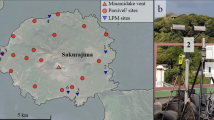Abstract
We compare two of the most common methods of quantifying mass flux, particle numbers and particle-size distribution for drifting snow events, the snow-particle counter (SPC), a laser-diode-based particle detector, and particle tracking velocimetry based on digital shadowgraphic imaging. The two methods were correlated for mass flux and particle number flux. For the SPC measurements, the device was calibrated by the manufacturer beforehand. The shadowgrapic imaging method measures particle size and velocity directly from consecutive images, and before each new test the image pixel length is newly calibrated. A calibration study with artificially scattered sand particles and glass beads provides suitable settings for the shadowgraphical imaging as well as obtaining a first correlation of the two methods in a controlled environment. In addition, using snow collected in trays during snowfall, several experiments were performed to observe drifting snow events in a cold wind tunnel. The results demonstrate a high correlation between the mass flux obtained for the calibration studies (\(r \geqslant 0.93\)) and good correlation for the drifting snow experiments (\(r \geqslant 0.81\)). The impact of measurement settings is discussed in order to reliably quantify particle numbers and mass flux in drifting snow. The study was designed and performed to optimize the settings of the digital shadowgraphic imaging system for both the acquisition and the processing of particles in a drifting snow event. Our results suggest that these optimal settings can be transferred to different imaging set-ups to investigate sediment transport processes.















Similar content being viewed by others
References
Bagnold R (1935) The movement of desert sand. Geogr J 85(4):342–365
Bagnold RA (1941) The physics of wind blown sand and desert dunes. Methuen, London, 256 pp
Burri K, Gromke C, Lehning M, Graf F (2011) Aeolian sediment transport over vegetation canopies: a wind tunnel study with live plants. Aeolian R 3(2):205–213. doi:10.1016/j.aeolia.2011.01.003
Clifton A, Rüedi JD, Lehning M (2006) Snow saltation threshold measurements in a drifting-snow wind tunnel. J Glaciol 52(179):585–596. doi:10.3189/172756506781828430
Clifton A, Manes C, Rüedi JD, Guala M, Lehning M (2008) On shear-driven ventilation of snow. Boundary-Layer Meteorol 126(2):249–261. doi:10.1007/s10546-007-9235-0
Doorschot JJ, Lehning M, Vrouwe A (2004) Field measurements of snow-drift threshold and mass fluxes, and related model simulations. Boundary-Layer Meteorol 113(3):347–368. doi:10.1007/s10546-004-8659-z
Gordon M, Taylor PA (2009) Measurements of blowing snow, part i: particle shape, size distribution, velocity, and number flux at Churchill, Manitoba, Canada. Cold Reg Sci Technol 55(1):63–74. doi:10.1016/j.coldregions.2008.05.001, http://www.sciencedirect.com/science/article/pii/S0165232X08000736
Gordon M, Savelyev S, Taylor PA (2009) Measurements of blowing snow, part ii: mass and number density profiles and saltation height at Franklin bay, NWT, Canada. Cold Reg Sci Technol 55(1):75–85. doi:10.1016/j.coldregions.2008.07.001, http://www.sciencedirect.com/science/article/pii/S0165232X0800102X
Gromke C, Manes C, Walter B, Lehning M, Guala M (2011) Aerodynamic roughness length of fresh snow. Boundary-Layer Meteorol 141(1):21–34. doi:10.1007/s10546-011-9623-3
Gromke C, Horender S, Walter B, Lehning M (2014) Snow particle characteristics in the saltation layer. J Glaciol 60(221):431–439. doi:10.3189/2014JoG13J079
Groot Zwaaftink C, Cagnati A, Crepaz A, Fierz C, Macelloni G, Valt M, Lehning M (2013) Event-driven deposition of snow on the antarctic plateau: analyzing field measurements with snowpack. The Cryosphere 7(1):333–347. doi:10.5194/tc-7-333-2013
Guala M, Manes C, Clifton A, Lehning M (2008) On the saltation of fresh snow in a wind tunnel: profile characterization and single particle statistics. J Geophys Res: Earth Surface (2003–2012) 113(F3), doi:10.1029/2007JF000975
Kim KS, Kim SS (1994) Drop sizing and depth-of-field correction in tv imaging. At Sprays 4(1):65–78. doi:10.1615/AtomizSpr.v4.i1.30
Kimura MTIT T (1993) Design and making of spc-vii p pp. 665–670 (in Japanese)
LaVision-GmbH (2011) Product-manual for davis 8.0 pp 9–46
Nishimura K, Nemoto M (2005) Blowing snow at mizuho station, antarctica. Philos Trans Roy Soc 363(1832):1647–1662. doi:10.1098/rsta.2005.1599
Nishimura K, Sugiura K, Nemoto M, Maeno N (1998) Measurements and numerical simulations of snow-particle saltation. Ann Glaciol 26:184–190
Paterna E, Crivelli P, Lehning M (2016) Decoupling of mass flux and turbulent wind fluctuations in drifting snow. Geophys Res Lett pp n/a–n/a. doi:10.1002/2016GL068171, http://dx.doi.org/10.1002/2016GL068171, 2016GL068171
Pokorny M, Horender S (2014) Measurement of particle rotation in a saltation layer. Earth Surf Process Landf 39(13):1803–1811. doi:10.1002/esp.3568
Schirmer M, Lehning M, Schweizer J (2009) Statistical forecasting of regional avalanche danger using simulated snow-cover data. J Glaciol 55(193):761–768. doi:10.3189/002214309790152429
Schmidt R (1977) A system that measures blowing snow. Rocky Mountain Forest and Range Experiment Station, Forest Service, US Department of Agriculture
Schmidt R (1986) Transport rate of drifting snow and the mean wind speed profile. Boundary-Layer Meteorol 34(3):213–241. doi:10.1007/BF00122380
Sugiura K, Nishimura K, Maeno N, Kimura T (1998) Measurements of snow mass flux and transport rate at different particle diameters in drifting snow. Cold Reg Sci Technol 27(2):83–89. doi:10.1016/S0165-232X(98)00002-0
Walter B, Gromke C, Lehning M (2012a) Shear-stress partitioning in live plant canopies and modifications to raupachs model. Boundary-Layer Meteorol 144(2):217–241. doi:10.1007/s10546-012-9719-4
Walter B, Gromke C, Leonard K, Clifton A, Lehning M (2012) Spatially resolved skin friction velocity measurements using irwin sensors: a calibration and accuracy analysis. J Wind Eng Ind Aerodyn 104:314–321. doi:10.1016/j.jweia.2012.02.018
Walter B, Gromke C, Leonard KC, Manes C, Lehning M (2012c) Spatio-temporal surface shear-stress variability in live plant canopies and cube arrays. Boundary-Layer Meteorol 143(2):337–356. doi:10.1007/s10546-011-9690-5
Walter B, Horender S, Voegeli C, Lehning M (2014) Experimental assessment of owen’s second hypothesis on surface shear stress induced by a fluid during sediment saltation. Geophys Res Lett 41(17):6298–6305. doi:10.1002/2014GL061069
Acknowledgments
The authors wish to express their acknowledgment to the Swiss National Science Foundation (SNF) for funding this research (R grant number 200021_147184) as well as to Christof Gromke and the SNF (REquip grant number 206021_133786) for installing the PTV equipment. We further thank Prof. Kouichi Nishimura for his support in operating the SPC, Matthias Jaggi for his contribution concerning electronics issues, the SLF workshop team that helped to prepare all the hardware at the wind tunnel as well as the reviewers for their valuable and constructive input.
Author information
Authors and Affiliations
Corresponding author
Rights and permissions
About this article
Cite this article
Crivelli, P., Paterna, E., Horender, S. et al. Quantifying Particle Numbers and Mass Flux in Drifting Snow. Boundary-Layer Meteorol 161, 519–542 (2016). https://doi.org/10.1007/s10546-016-0170-9
Received:
Accepted:
Published:
Issue Date:
DOI: https://doi.org/10.1007/s10546-016-0170-9




